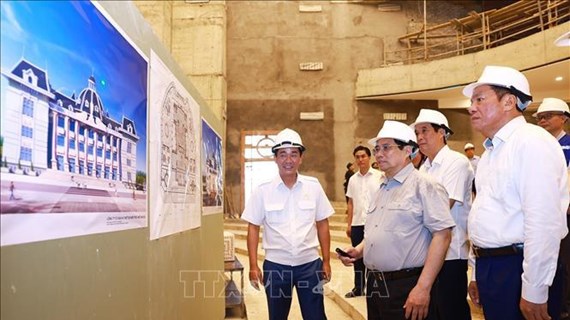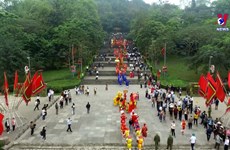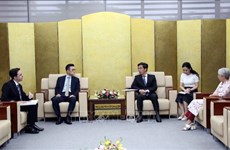HCM City struggles to diversify tourism products
 Visitors enjoy a boat ride on the Nhieu Loc-Thi Nghe canal in HCM City. The 4.5-km route takes them through four central districts – 1, 3, Binh Thanh and Phu Nhuan. (Source: VNA)
Visitors enjoy a boat ride on the Nhieu Loc-Thi Nghe canal in HCM City. The 4.5-km route takes them through four central districts – 1, 3, Binh Thanh and Phu Nhuan. (Source: VNA)HCM City (VNA) - For over a decade the pace of tourism development in HCM City has been rather slow due to limited products in terms of places of interest and cultural and entertainment activities for tourists.
Though the city is a tourism hub visited by 56 percent of all foreign arrivals in Vietnam, the tourism sector accounts for less than 10 percent of its economy.
Visitors coming on package tours to Vietnam usually spend two nights in HCM City before leaving for other places, said Ka Sa Ha Klas, a tour guide working for Indochina Tourism, said.
It takes only half a day to visit popular tourist attractions. Visitors are taken to the Mekong Delta the next day and return to the city for another day before leaving for northern provinces, he said.
Few changes have been made in years to further develop tours as a result of which the city has been unable to keep visitors interested for long.
“The city has become a stopover point,” Klas said.
“Foreign tourists prefer to visit cultural and heritage sites in northern provinces.”
Andrew Sharman, 57, an Australian tourist on a six-day tour to Vietnam with his wife, spent one night in HCM City before leaving for Hoi An and Hanoi.
Speaking of HCM City, Dao Vinh Hop of Saigon University said a wealth of cultural and heritage sites in a city with more than 300 years of history remains unexplored.
The material and non-material cultures of Saigon-Cho Lon offer a unique brand of cultural heritage tourism, but the potential has not been promoted or exploited properly, he said.
Though the city’s tourism infrastructure is well developed compared to other places and major travel agents are based here, it remains a transit point for tourists on their way to visiting heritage sites in other localities, he said.
Huynh Anh Tuan, Director of Thai Duong Theatre and Art Co. Ltd, said the War Remnants Museum is the city’s most popular tourist attraction.
There is a lack of sophisticated and well-organised cultural and arts offerings for foreign tourists to enjoy and experience the city’s 300-year history, he said.
Efforts to diversify tourism products
The city government is crafting a master plan for tourism from now through 2020, which seeks to increase the tourism sector’s contribution to the economy to above 11 percent.
The plan would focus on sustainable and responsible tourism and heritage conservation to spur the city’s prosperity as well as benefit enterprises and bring well-being to the community, Tran Vinh Tuyen, Deputy Chairman of the city People’s Committee, said.
The tourism sector should diversify its products to make it one of the major drivers of the city’s economy, he said.
Nguyen Viet Anh, head of the city Department of Tourism’s travel division, told Vietnam News that numerous initiatives have been taken to spur tourism growth.
The tourism authority is now promoting rural tourism, craft tourism, river tourism and eco-tourism, he said.
The city has five rural districts, which have potential for rural and craft tourism, he said.
The tourism diversification plan focuses on river and canal tours, he said.
Last year an inner waterway tourism route along the Nhieu Loc-Thi Nghe canal was started.
The 4.5-km route passes through four central districts of the city – 1, 3, Binh Thanh and Phu Nhuan.
Many foreign tourists now opt for a recently started speedboat tour from HCM City to Cu Chi Tunnels, he said.
An eco-tour by boat to the Can Gio Biosphere Reserve from Bach Dang Wharf in District 1 is also part of the river tourism development plans, he added.
More efforts are needed from stakeholders, including state agencies and the public, to ensure canals and rivers are kept clean.
Tourism products can be enhanced by the addition of cultural elements and sophisticated entertainment, La Quoc Khanh, Deputy Director of the city Department of Tourism, said.
He admitted that cultural and arts shows are not well organised, resulting in less than attractive tourism products.
Four in 100 tourists visiting the city go to arts performances, according to a survey done by organisers of such programmes.
Most Asian countries have 1,000-seater theatres to provide space for artists performing regularly, but there is no such space for art and entertainment shows in HCM City.
There are just a few popular performances in the city like traditional Vietnamese puppet shows at the Golden Dragon Water Puppet Theatre, the History Museum and Rex Hotel, A O Show (a mix of bamboo cirque, acrobatics and contemporary dance) at the Saigon Opera House, and Hon Viet Show (the soul of Vietnam) featuring seven acts about ancient stories from Vietnamese history and traditional music.
Vo Thanh Trung, Chairman of Square Group, which produces the popular A O Show, said finding a venue is the biggest challenge for the show since the Saigon Opera House is the only one in town that can host it now, and it is often not available.-VNA













